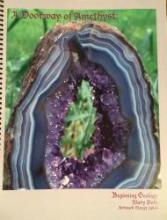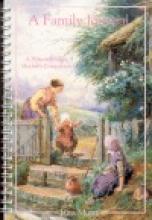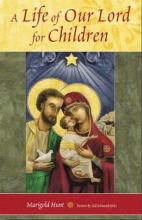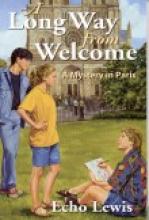No name
A Doorway of Amethyst
Here is a geology text that assumes no conflict between Christianity and science and is faithful to Church teaching. This book covers basic topics in geology, including the Earth's age and composition, the dynamics of continental plate motion, classification of rocks and soil, effects of glaciers, radiometric dating, and more. The illustrations are lovely and hand-drawn – not what you would expect in a textbook. However, I prefer a few glossy photographs as well, but you can find these on the internet. I was unfamiliar with many of the geologic terms so I learned a lot along side my 12-year-old daughter. I especially appreciated the author's explanation of evolution in the appendix and Chapter 11 on the geologic column in the Williston Basin.
I allotted 18 weeks to finish this book, but it took 22 weeks, rushing a bit. The book has suggested research activities at the end of most chapters, but we did not do very many of them. (I had already ”planned” one semester of chemistry to follow one semester of geology.) The last chapter consists of short biographies of mostly Catholic scientists. There is also a suggested reading list at the end of the book. Exercises are included at the end of each chapter - lots of crosswords, matching, fill-in-the-blank, multiple choice, etc. There are also poems interspersed throughout the text to aid in memorization. If we had done more research activities and added supplemental reading, this book would expanded into a full-year course. There were no tests included so it was necessary to make some to reinforce the material.
Mary Daly mostly separates scientific considerations from philosophical ones. She sticks her opinions in the appendices. However, the one exception is in the first chapter when she explains charitably that Young Earth Creationism is inconsistent with scientific evidence.
Here are some of the ideas (as far as I can understand) that really distinguish this book from most geology texts aimed at the home school market:
- The text is consistent with our Catholic Faith.
- Radiometric dating of rocks shows that the Earth is about 4.5 billion years old.
- While we are all descended from two first parents, the fossil record points to a single "family tree of life" of which we are a part.
- Evolution of new species by natural selection is an incomplete explanation of the fossil record. In an appendix, the author suggests that additional mechanism is needed to account for the sudden appearance of new species in the fossil record. John Davison, a professor of zoology, developed a semi-meiotic hypothesis as just this sort of mechanism. I found this very intriguing since it is compatible with what is observed and is testable. Mary Daly also suggests that some paleontologists have a philosophical bias that prevents them from considering other scientific explanations.
- The geologic record does not support a worldwide flood. Mary Daly explains there is not enough water on Earth to do this. She suggests that Noah's flood was probably a catastrophic flood that affected the part of the world known to the inspired writer.
Overall, I think A Doorway of Amethyst is a very good, well-written geology text. I am grateful that Mary Daly took the time to write it. I recommend it and plan to use it again. Next time, I would want to write cumulative quizzes for each chapter, allow more time for supplemental reading, and incorporate more projects and writing assignments. (I can dream, anyway.)
You can view sample pages at the end of this document on the author's Hedge School website.
This is a 1st edition of the text, and my daughter found quite a few typographical errors in it.
Reviewed by Pam Blakeslee
A Family Journal
Rita Munn is a Catholic homeschool mother of ten. She is part of the Mom-to-Mom Connections team at Catholic Heritage Curricula.
A Grace Given
A Landscape with Dragons
This book has helped me to understand the importance of stories in a child's spiritual and intellectual formation. Mr. O'Brien explains how mythology, fiction, fantasy and fairy tales help children understand the real world - both what we can see and what we can't see. Stories help teach children the difference between right and wrong, good and evil. Unfortunately, many fiction stories give the wrong messages about good and bad. Mr. O'Brien gives parents the tools to tell good from bad and includes his own analysis of some popular stories and several Disney movies. Some of the work is rather scholarly and perhaps even heavy-handed at times. In particular, his theories about good fantasy, which even the Chronicles of Narnia and the Lord of the Rings can't quite live up to, seem overly particular to me.
Because of all the problems with offensive content in modern books and movies, I think it's easy for parents to fall into judging books and movies JUST by whether or not they are "clean." The problem with this is that some materials that appear to be non-offensive have problems of a more subtle nature. Conversely, there are some really fine books and movies that have some unfortunate scenes or even some scenes that seem offensive but are important to the story. A Landscape With Dragons helps sort out what's good and what's bad in a meaningful, rather than superficial way.
This book also contains an extensive recommended reading list compiled by the staff of Bethlehem Books. It's a very helpful resource categorized into Picture Books, Easy Readers, Short Chapter Books, Books for Intermediate Readers, and Adult Titles which are suitable for older teens. Included are many good secular titles that you can probably find in your local library. Also, titles are marked to let you know which ones are currently in print.
In keeping with the notion of deciding for yourself on some of the finer points (and remembering that good Catholics will disagree on some of these details), it is interesting to note that there are a few discrepencies between Michael O'Brien's recommendations and those present in the recommended book list from Bethlehem Books.
A Life of Our Lord for Children
Sophia Institute Press has reprinted another gem! In an easy conversational manner, Marigold Hunt tells the story of the Life of Christ. She begins by spending one chapter on the time before Christ, the promise, and the prophets. Then she tells of his birth and young life, his preaching and miracles, and his death and resurrection. The last chapter, His Kingdom is the Church, tells of the Pentecost.
The pictures make this edition really special. There are thirty, done in an almost icon-like style. I have two favorites. The first is of the storm on the Sea of Galilee while Jesus sleeps and the apostles panic. The view is from above. The second is a picture that has a small drawing of each apostle with some symbol to represent who he is. The spot for Judas is darkened. My children had a fun time deciding the name of each apostle based on the symbols. Another interesting detail is that the artist is a homeschooling dad!
When I first saw the book, I wondered at the need of it. If you wanted your children to know the story of Christ, I thought, why not read the Bible. But as I read it I saw that the way Mrs. Hunt tells the story makes a big difference. She claims that she is not telling everything that is in the bible, but a little, so that the children understand and can someday read the bible themselves. It is almost like a conversation she is having, with stops for explaining things, just as I would tell my children about something. For example when she talks about the coming of the Messiah, she explains why He is called the Messiah and the Christ and the King. I thought the storytelling fashion, the second person manner of writing, must be what it was like in the early days of the Church when the story of Christ passed to people by word of mouth, or like in later ages when not everyone read, but yet knew the story of Christ. For this reason I think it would make a great read aloud.
Copyrights 1939/2003
A Life With Karol,
A Litany of Saints
Do you know why we should ask the saints to pray for us? Do you know what happened to St. Christopher? Do you know who is the protector from cancer? If not, then you need to read this book and have your questions answered!
Imprimatur (1992) and Nihil Obstat
Many thanks to Saint Gabriel's for donating this book for review.
A Little History of the World
This is the kind of book that is written for children and yet any adult will enjoy it immensely. We listened to it during a summer trip, and all of our children, from 6 to 20 years old, were enthralled. Reader Ralph Coshan won an audio award for the reading of the book and we have truly grown to love the sound of his voice. Gombrich's A Little History of the World is right up there with Hillyer's A Child's History of the World, but even better--which I never thought I would say, as A Child's History of the World has been a favorite of mine for years. Gombrich himself revised and translated his 1930's text into English before his death in 2002. This is why we have a recent publication in English of a European bestselling history text for children from the 1930s! The text is geared to children a bit older than the Calvert School classic, which is good for a homeschooling family. I love the way the author dealt with a huge Catholic theme: the Reformation! And I love the fact that there is a whole chapter on the Counter-Reformation, which is largely ignored by the American public when studying European history. His account of Saint Ignatius Loyola's story and the founding of the Company of Jesus (Jesuits) makes this volume very Catholic-friendly indeed, which is something to be said for a history book from any major secular publisher. The way the author refers to God, and to the person of Jesus Christ, and to His teachings, is very respectful and wonderfully done. In my research about Gombrich's faith life, I learned that he converted to Christianity from Judaism early in his life. I am currently leading a History 3rd/4th grade small class using Hillyer's text and comparing/complementing it with Van Loon's Story of Mankind. I believe these three volumes together can make up a superb World History curriculum for elementary school! Hedgeschool's First Timeline, done in first and second grades, would be a great place to start. Highly recommended. This will be a great addition to your homeschool audio library.
A Long Way from Welcome
The story is a fun quick read for ages 12 and up. The convent itself is fascinating with its hidden panels and secret passages. The experience would be further enhanced by checking out some guide books of Paris and architecture books (that include the Cathedral of Notre Dame and the Beaubourg) from your local library.
This title was donated for review by Bethlehem Books










